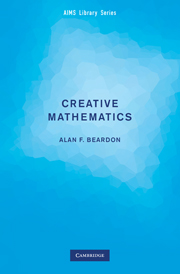12 - Problem H: Solution
Published online by Cambridge University Press: 16 May 2024
Summary
The segment L(k) meets the square S(a, b) if and only if the bottom left-hand corner of S(a, b) lies on or below the line x + y = k, and the top right-hand corner lies on or above this line. Thus L(k) meets S(a, b) if and only if
It follows that N(k) is the number of pairs (a, b) of non-negative integers such that k − 2 ≤ a + b ≤ k, and it is apparent that N(k) depends critically on whether k is an integer or not.We let [k] be the integer part of k.
Lemma Let N(k) be defined as above. Then
Proof It is clear that N(0) = 1. For each integer m, let Ф(m) be the number of pairs (a, b) of non–negative integers a and b with a + b = m. Then a simple count shows that Ф(m) is max﹛m + 1, 0﹜.
as required.
We now consider the average value of (k; a, b) taken over those squares S(a, b) that meet the segment L(k). As the sum of the lengths (k; a, b) of the segments is the length of L(k), which is k we see that
If k→∞ through integer values, then A(k) is equal to, and so tends to. If k→∞through non–integer values, then k/[k] → 1 so that A(k) tends to
• Can you give a simple intuitive reason why the limit is When k→∞through integer values?
• Suppose that t is chosen at random from the interval [0, 2], and let 0(t ) be the length of the intersection of the square S(0, 0) with the line x + y = t . What is the expected value of 0(t ), and how does this compare with the limiting values of A(k) as k→∞?
• Now try the same problem in three dimensions. Divide the first octant of three-dimensional space into unit cubes, and consider the triangle T (k) lying in the plane x + y + z = k, with vertices (k, 0, 0), (0, k, 0) and (0, 0, k). What is the limiting behaviour of the average area of the intersection of T (k) with a unit cube?
- Type
- Chapter
- Information
- Creative MathematicsA Gateway to Research, pp. 59 - 60Publisher: Cambridge University PressPrint publication year: 2009



